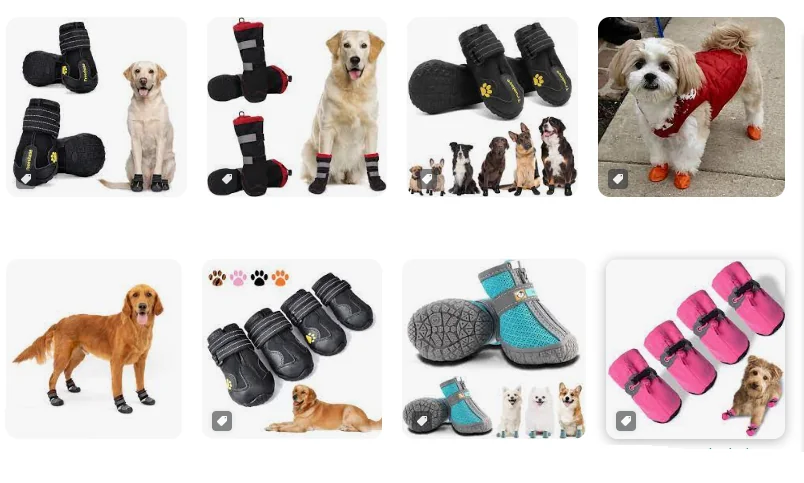
Watching your dog limp across a hot pavement or struggle on icy paths is more than just an ‘ouch’ moment. It’s a wake-up call. You’re about to discover the when, why, and how of choosing the right protection for your furry friend’s paws—dog boots to the rescue.
Quick Takeaways:
- Measure your dog’s paws accurately and choose boots made from durable, weather-appropriate materials to ensure comfort and protection.
- Dog boots not only prevent injuries but also aid in the recovery of existing wounds and enhance mobility for senior dogs with joint issues.
- Introduce dog boots gradually with positive reinforcement to acclimatize your pet, considering alternatives like paw balm or dog socks if they resist wearing them.
Why Do Dogs Need Boots?
When we think about dog boots, the image that comes to mind might be a pooch prancing awkwardly in new shoes. But these little booties serve a much more critical function than making a fashion statement.
From scorching pavements in the summer to the icy sidewalks in the winter, extreme temperatures can be harmful to your dog’s paws. Dogs venturing into rugged terrains with sharp rocks, thorns, or toxic substances also face significant risks to their paw health. And let’s not overlook our furry friends with medical conditions that affect their mobility and comfort. The need to protect their paws becomes paramount in ensuring their overall well-being.
Situations Where Dog Boots are Necessary:
- Extreme Weather Conditions: Both hot and cold pavements can cause blisters, burns, or frostbite on your dog’s delicate paw pads.
- Adventures in Rugged Terrain: Hiking or walking in areas with sharp rocks, thorns, or harmful substances can lead to cuts, punctures, and infections.
- Medical Conditions: Dogs recovering from paw injuries or those with mobility issues can benefit greatly from the added support and protection that boots offer.
Protecting your dog’s paws is more than a comfort issue—it’s about ensuring their adventures outside don’t turn into painful ordeals.
How to Choose the Right Dog Boots?
Selecting the perfect pair of boots for your canine companion involves a bit more than picking the cutest pair. The right fit, material, and type are crucial to ensure that the boots serve their purpose without causing discomfort. Here’s a straightforward guide to help you navigate the options:
- Measure Your Dog’s Paws: To avoid the all-too-common slip-off, make sure you measure your dog’s paw width and length accurately. Most brands provide sizing charts for reference.
- Opt for Durable Materials: Look for breathable, yet tough materials that can withstand the conditions your dog will face, whether it’s hot asphalt or snowy paths.
- Consider the Closure System: Velcro straps or elastic bands ensure a snug, secure fit, and make the boots easier to put on and take off.
- Look for Special Features: Depending on your dog’s activity level and the terrain, you might want boots with anti-slip soles, water resistance, or reflective materials for better visibility during nighttime walks.
Pro Tip: For a unique piece of advice, consider the season and your environment before making a purchase. For winter, boots with insulating properties are a must, whereas, for summer, opt for lighter, more breathable options to prevent overheating.
Can Dog Boots Help with Health Issues?
Absolutely. Beyond the basic protection from injuries, dog boots can play a crucial role in managing and preventing health issues. They’re not just accessories—they’re tools for better health.
- Injury Recovery: Boots can provide a clean environment for wounds, reducing the risk of infection and aiding the healing process by minimizing licking or biting at bandages.
- Prevent Infections: In areas where the ground may be contaminated with harmful bacteria or chemicals, boots act as a barrier to prevent contact and subsequent infections.
- Support for Elder Dogs: Senior dogs with arthritis or degenerative diseases affecting their paws and mobility can find relief with the right pair of boots. It can enhance their traction, reducing the strain on their joints and making movement less painful.
By choosing dog boots tailored to your dog’s specific health conditions and ensuring a proper fit, you’re not just investing in their immediate comfort. You’re taking a step towards proactively managing their long-term health and mobility. Protecting their paws can lead to a happier, more active lifestyle, even for dogs facing challenging health issues.
Are There Alternatives to Dog Boots?
Sometimes, despite our best efforts, our furry friends just won’t cozy up to the idea of wearing boots. And that’s perfectly okay! The good news is, there are several other ways to protect those precious paws without causing your pooch distress. Let’s dive into some paw-protecting alternatives:
-
Paw Balm: Think of it as a moisturizer for your dog’s feet. Not only does it heal cracked pads, but it also creates a protective layer against harsh surfaces like hot pavements or icy sidewalks. Reapply as necessary, especially during extreme weather conditions, to keep their paws soft and safe.
-
Temporary Paw Protectors: Imagine a balloon for your dog’s paws – that’s essentially what these are. They’re more flexible than traditional boots and can be a good middle ground for dogs that tolerate them better. They’re perfect for a quick trip outside and are often disposable.
-
Dog Socks: Yes, they exist, and they’re as cute as they sound. Socks can provide grip on slippery indoor surfaces and offer a mild layer of protection from outdoor elements. Plus, they can help dogs get accustomed to the sensation of having something on their feet, serving as a good first step toward wearing boots.
-
Rug and Carpet Runners: For indoor protection, strategically placed rugs can help. They’re particularly useful for seniors or dogs with mobility issues, providing them necessary grip to move around safely inside the house.
A highly specific tip most don’t mention: For especially hot days, create a makeshift cold wrap for your dog’s paws. Dip a cloth in cold water, wring it out, and gently wrap it around their paws one at a time. This can be a soothing treatment after walks on hot pavement or sand.
How to Get Your Dog Used to Wearing Boots?
Getting your dog to happily wear boots is more art than science, involving patience, positive reinforcement, and a sprinkle of creativity. Here’s a step-by-step guide to turning those boot-woes into boot-wows:
-
Start Slow: Begin by introducing the boots in a calm, relaxed environment. Let your dog sniff and explore them to understand they’re not a threat.
-
Associate With Positive Reinforcements: Every time your dog interacts with the boots (even just a sniff), offer a treat or their favorite toy. It’s all about creating positive associations.
-
Try Them On During Happy Times: Slip the boots on right before mealtime or playtime, so they associate wearing boots with things they love.
-
Keep Initial Sessions Short: Start by having your dog wear the boots for just a few minutes a day, gradually increasing the time as they get more comfortable.
-
Praise and Treat: Don’t skimp on the praise or treats! Every step they take in those boots is a step worth celebrating. Make a big deal out of it to let them know how proud you are.
-
Create a Routine: Dogs love routine. Try to incorporate boot-wearing into your daily schedule consistently. This predictability helps reduce stress and resistance.
Here’s a unique piece of advice: For dogs that are particularly resistant, try placing only the front or back paws in boots first. Many dogs tolerate this better and it allows them to slowly adjust to the sensation of wearing boots, rather than overwhelming them by putting all four on at once.
Remember, patience is key. It might take days or even weeks for your dog to fully accept their new footwear. But with your encouragement and understanding, you’ll soon have a dog that sees their boots as just another part of their daily adventures. Keep it light, keep it fun, and celebrate the small victories along the way. And remember, every dog is different; what works for one may not work for another. Stay adaptable, stay positive, and you’ll both find your way.
Alex, a passionate animal lover, has experience in training and understanding animal behavior. As a proud pet parent to two dogs and three cats, he founded AnimalReport.net to share insights from animal experts and expand his knowledge of the animal kingdom.





This webpage is outstanding. The site owner’s passion is evident in the excellent content. I’m in awe and anticipate reading more amazing pieces like this one.